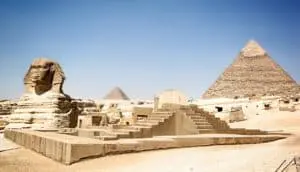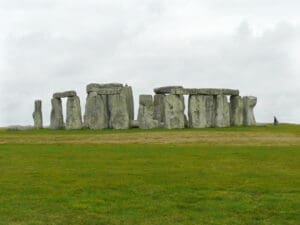The Great Wall of China: Exploring Historical Facts and Cultural Significance
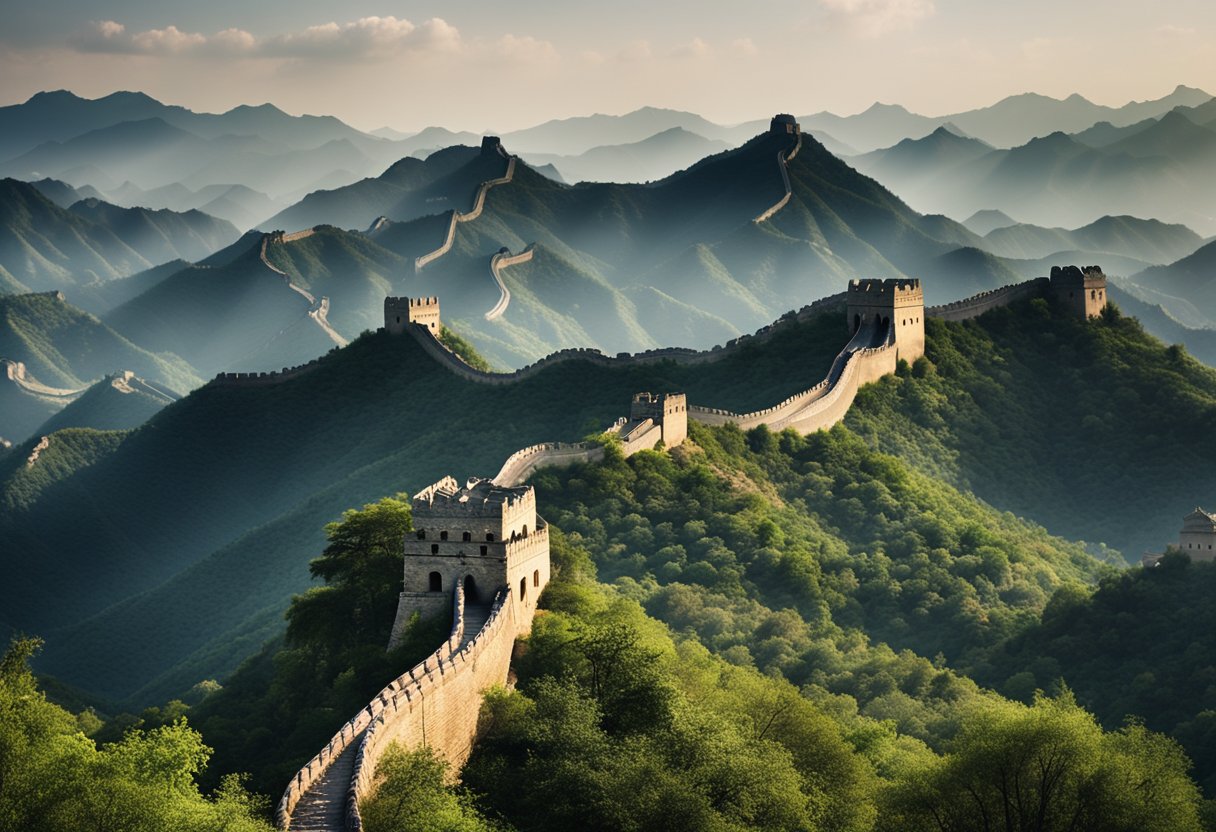
Updated On: April 17, 2024 by Eman Sameh
The Great Wall of China stands as one of history’s most incredible achievements. It is an ancient fortification that not only stretches across a vast expanse of diverse terrain but also embodies the profound depth of China’s history and cultural identity. Constructed over several dynasties, with the most significant contributions from the Ming Dynasty, the wall represents over two millennia of architectural evolution and strategic significance in safeguarding the realm from invasions. It weaves through mountains, grasslands, and deserts, symbolising an ancient civilisation’s determination and ingenuity.
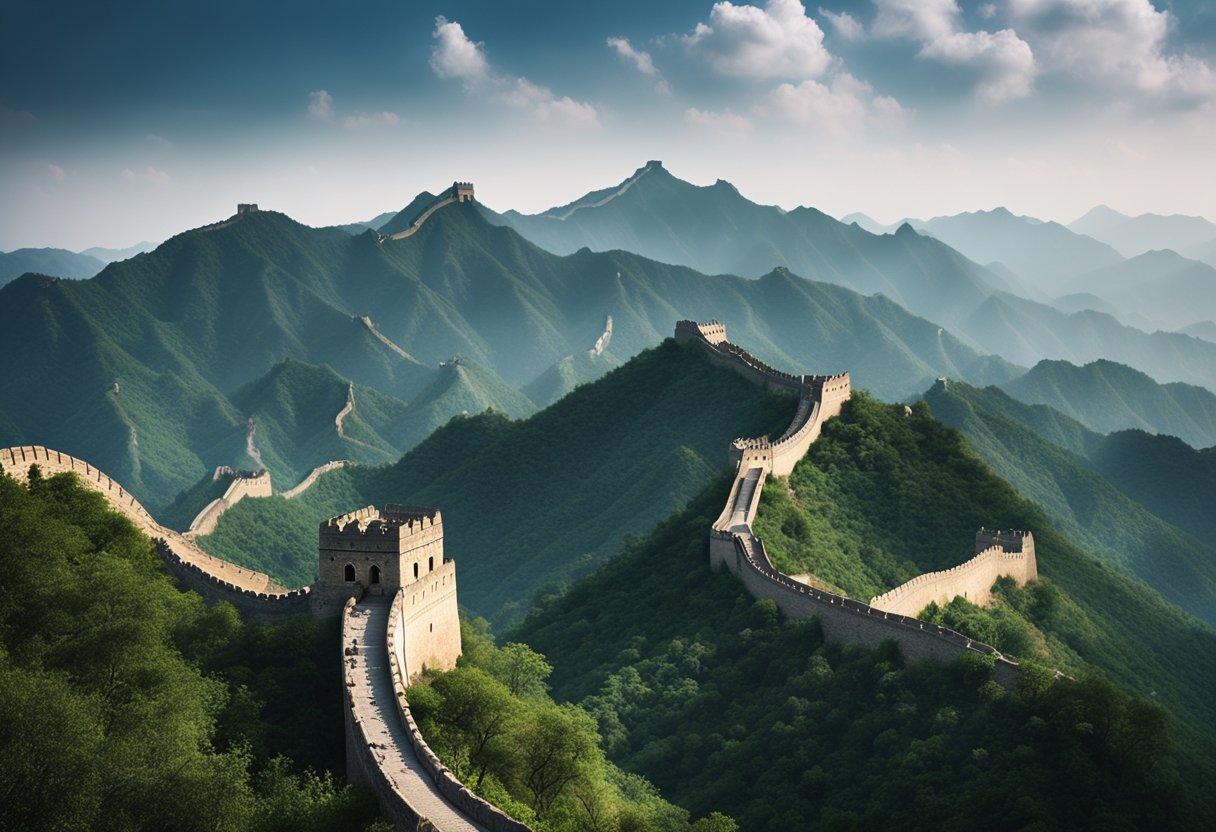
While famous for its historical and architectural grandeur, the Great Wall transcends its physical presence, encapsulating an enduring cultural legacy that resonates throughout China and beyond. It has long stirred the global imagination, giving rise to countless myths and misconceptions, and remains a poignant reminder of China’s ability to mobilise its people to accomplish monumental tasks. As a UNESCO World Heritage site, the Great Wall is not only a testament to humanity’s creative spirit but also a focus for ongoing preservation efforts, playing a significant role in modern tourism and the economy while sparking interest in the natural impact and ecology surrounding it.
Historical Context
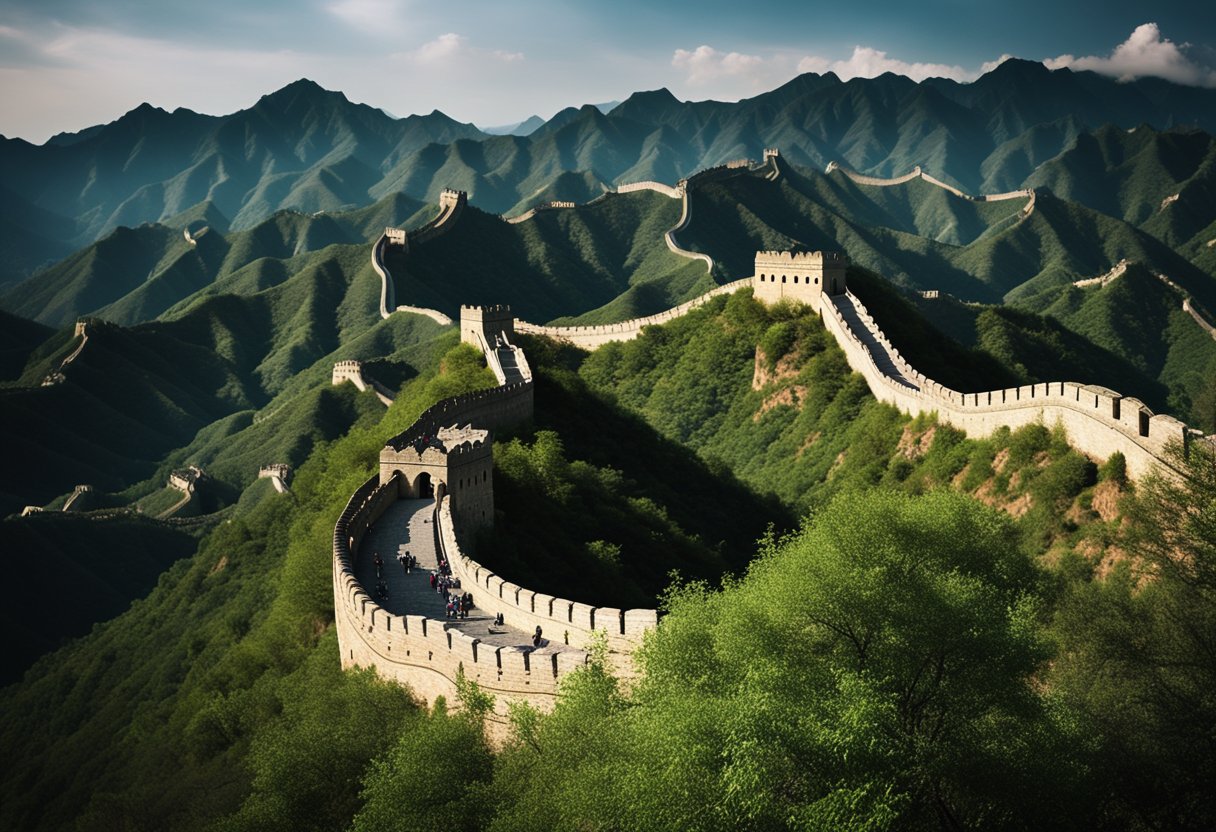
Exploring the Great Wall of China requires us to traverse the annals of history, understanding its inception and evolution through various dynastic contributions. Our journey begins with the imperial vision that set the foundation for this monumental structure.
Dynastic Contributions
The Great Wall, as we know it, is the result of cumulative efforts by multiple dynasties. Originally conceived as several disparate walls, the Qin Dynasty (221–206 BCE) initiated the most expansive military fortification project during the Warring States period to safeguard against northern invasions. Over time, the Han Dynasty (206 BCE–220 CE) extended and reinforced the wall, reflecting their commitment to defence and infrastructure. It was the Ming Dynasty (1368–1644), however, that played a pivotal role in sculpting the edifice’s most recognisable sections—an undertaking exemplifying the zenith of wall construction, integrating sophisticated defence systems and watchtowers.
Emperor Qin Shi Huang’s Vision
The impetus for the Great Wall can largely be attributed to the strategic foresight of the First Emperor, Qin Shi Huang. Determined to unify China and protect it from northern incursions, Qin Shi Huang laid down the precursor to the present structure during the Warring States Period. Commandeering the labour of millions, the emperor fortified existing walls and connected them, leading to the conception of a unified defence mechanism – a hallmark of military ingenuity that outlasted his reign and his Qin Dynasty, providing a lasting legacy that continues to intrigue and awe us to this day.
Architectural Marvel
The Great Wall of China stands as a testament to ancient engineering prowess, showcasing sophisticated construction techniques and a variety of materials that have withstood the passage of time.
Construction Techniques
Our examination reveals that the Great Wall was constructed using several innovative methods. The core section of the wall was made using rammed earth, which involved tamping down earth and gravel between wooden frames. This technique created a solid and sturdy foundation, which was later augmented with bricks and stone to construct the imposing ramparts and battlements of the wall.
Watchtowers were strategically spaced along the Great Wall. Each was meticulously planned to ensure visibility across the rugged terrain, serving as an early warning system against invaders. These solid fortifications were designed not only for defence but also to house troops, store supplies, and send smoke signals.
Diverse Materials
Materials for construction varied across different sections of the Wall, reflecting local resources. In the east, where stone was abundant, the wall primarily featured this durable material, while in the west, rammed earth and brick were more commonly utilised.
| Section | Main Materials Used |
|---|---|
| Eastern | Stone |
| Central | Brick, Stone |
| Western | Rammed Earth, Brick |
The fortifications incorporated into the wall demonstrate the use of diverse materials. While the main walls utilised large stone blocks and bricks, the fortifications utilised smaller bricks, tiles, limestone, and even taipa – a traditional form of rammed earth. The choice of materials has contributed to the longevity of the structure, each selected for its ability to endure harsh weather conditions and potential damage from military assaults.
Strategic Significance
The Great Wall of China has long been both a symbol and an instrument of strategic defence. It served as a robust fortification that marked the boundaries of empires and acted as a deterrent against invaders’ incursions.
Protection Against Invaders
The wall was a formidable barrier designed to safeguard the Chinese empire from the intrusions of nomadic tribes such as the Mongols. During the Ming Dynasty, its towering ramparts and watchtowers served as the empire’s first line of defence, alerting the garrisons to approaching threats. The mere presence of the Great Wall exemplified the might of the empire and its dedication to protecting its citizens.
Defence Infrastructure
Beyond its role as a passive shield, the Great Wall functioned as a sophisticated defence infrastructure. Connecting various fortresses and strategic passes allowed rapid movement and communication between military outposts along the frontier. Its construction, often following difficult terrains, highlighted the lengths to which the Ming, Jin, and Liao dynasties went to fortify their realms. It was much more than a simple wall; it was an integrated defence system that was crucial for the empire’s survival.
Geographical Span
The Great Wall of China encompasses a vast geographical range, communicating its historical importance as a northern frontier defence and displaying the geographical challenges ancient constructors overcame.
Northern Frontier Expanse
The wall extends from the east coast near Shanhai Pass, winding through Northern China and reaching as far as Gansu Province in the west. Its path traverses diverse terrains, from the rugged mountains that dominate provinces like Shanxi and Hebei to the harsh and variable expanses of the Gobi Desert. The Great Wall indeed served as a formidable northern boundary, especially during times when the Chinese empires focused on defending against nomadic tribes from Inner Mongolia and beyond.
Key Geographic Passes
Throughout its snaking course, the wall confronts numerous natural barriers, incorporating them into its infrastructure. Significant rivers and mountain ridges act not just as deterrents but are also utilised as strategic points of foundation for the wall’s construction. Among the several passes, Shanhai Pass stands out as a crucial gateway; historically coined as the ‘First Pass Under Heaven’, it signifies the wall’s eastern starting point and holds immense strategic value even to date.
Cultural Legacy
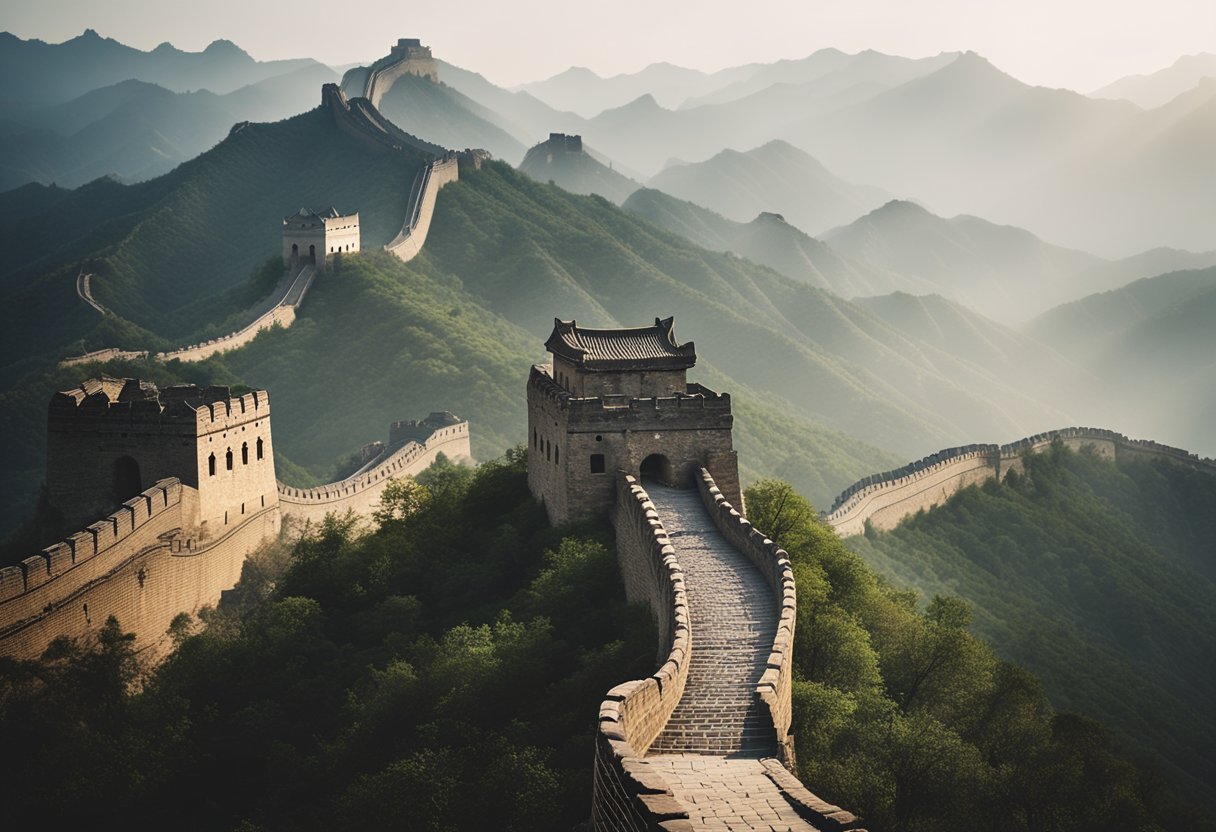
The Great Wall of China stands as a testament to ancient China’s civilisational prowess, symbolising both its architectural ingenuity and its culturally rich heritage.
UNESCO Recognition
The Great Wall, a renowned UNESCO World Heritage Site, is a celebrated icon of Chinese heritage, typifying the resilience and strategic importance of protective fortifications throughout history. Its recognition by UNESCO underscores the significance of this monument as an invaluable part of the world’s cultural heritage.
Representation in Popular Culture
Across media and popular culture, the Great Wall frequently emerges as the emblematic symbol of China’s historical grandeur. It has inspired countless works, ranging from films to literature, often portrayed alongside the revered dragon as a representation of strength and cultural identity. In turn, it shapes the global understanding of China’s rich past and contributes to the country’s image in the collective consciousness.
Tourism and Preservation
The Great Wall of China is a monumental testament to human endeavour, with particular sections like Badaling and Mutianyu being focal points for visitors. Tourism provides both opportunities and challenges to preservation efforts, ensuring that the wall’s story continues to be told without compromising its integrity.
Managing Visitor Impact
We acknowledge that popular sections of the Great Wall, such as Badaling, attract a significant inflow of tourists, which necessitates meticulous management to mitigate wear and tear. Strategies include:
- Regulating visitor numbers: Utilising ticketing systems to control the volume of tourists, especially during peak seasons.
- Informing visitors: Educating tourists about the Wall’s delicate state promotes respect and encourages responsible behaviour.
Restoration Efforts
To preserve this UNESCO heritage site for future generations, restoration is imperative. By focusing on the most vulnerable sections, like Simatai and Jinshanling, we ensure the conservation of the wall’s authentic features. Restoration activities comprise:
- In-depth assessments: Before restoration, experts examine the wall to identify the most deteriorated parts.
- Using traditional materials and techniques: Restorers use age-old methods and materials to maintain historical authenticity.
Through careful management of visitor impact and ongoing restoration, we strive to maintain the delicate balance between showcasing the Great Wall’s timeless allure and ensuring its survival amidst the pressures of modern tourism.
Economic Impact

In our examination of The Great Wall of China, it’s evident that its contributions extend well beyond its architectural grandeur. The Wall’s influence on economic development, particularly through trade and tourism, remains significant in modern times.
Trade Routes and the Wall
Historically, parts of The Great Wall played a crucial role in protecting the trade routes, notably the Silk Road, facilitating safe exchange between traders. This ancient network was essential in the development of commerce throughout the regions of Asia, connecting the thriving markets of China with distant economies. In Gansu, the Wall served as a fortification for the Silk Road, guarding the flow of silk, spices, and other valuable goods that were integral to the economic prosperity of subsequent dynasties.
Tourism Revenue
Today, The Great Wall is a magnetic attraction for global visitors, with tourism significantly bolstering modern economic development. The Great Wall, particularly well-preserved sections such as Jinshanling, has evolved into a major tour destination, attracting millions each year. These visitors contribute to the local and national economy, from entry fees to local artisan sales and hospitality services. Our insight into the current tourism revenue supports the continuation of preservation efforts, ensuring that this monumental structure remains a source of economic benefit as much as it is a cultural and historical icon.
Military History
Our inspection of the Great Wall of China’s military history reveals its strategic significance in ancient Chinese warfare. This monumental barrier has been a key player in numerous battles and sieges and served as a fundamental line of garrison and watch for soldiers across various dynasties.
Battles and Sieges
The Great Wall played a pivotal role in protecting Chinese states and empires against northern invaders, including the notorious Mongol forces. Notably, during the Ming dynasty, the Wall was the theatre for numerous military campaigns and stood as a formidable obstacle during invasions. For instance, the Ming soldiers successfully fended off the Manchu intrusion at the battle of Shanhaiguan in 1644, which later led to the establishment of the Qing dynasty.
Garrison and Watch
The maintenance and defence of the Wall were ensured by the presence of a substantial garrison comprising soldiers who patrolled and manned the fortifications. Beacon towers were built along the Wall as part of the military defence system, used by garrison soldiers to transmit signals and observe enemy movements. The layout of the Wall, which had various barriers and fortifications, provided logistical support across different wartime and peacetime periods, as aptly described in TravelChinaGuide’s accounts.
Natural Impact and Ecology
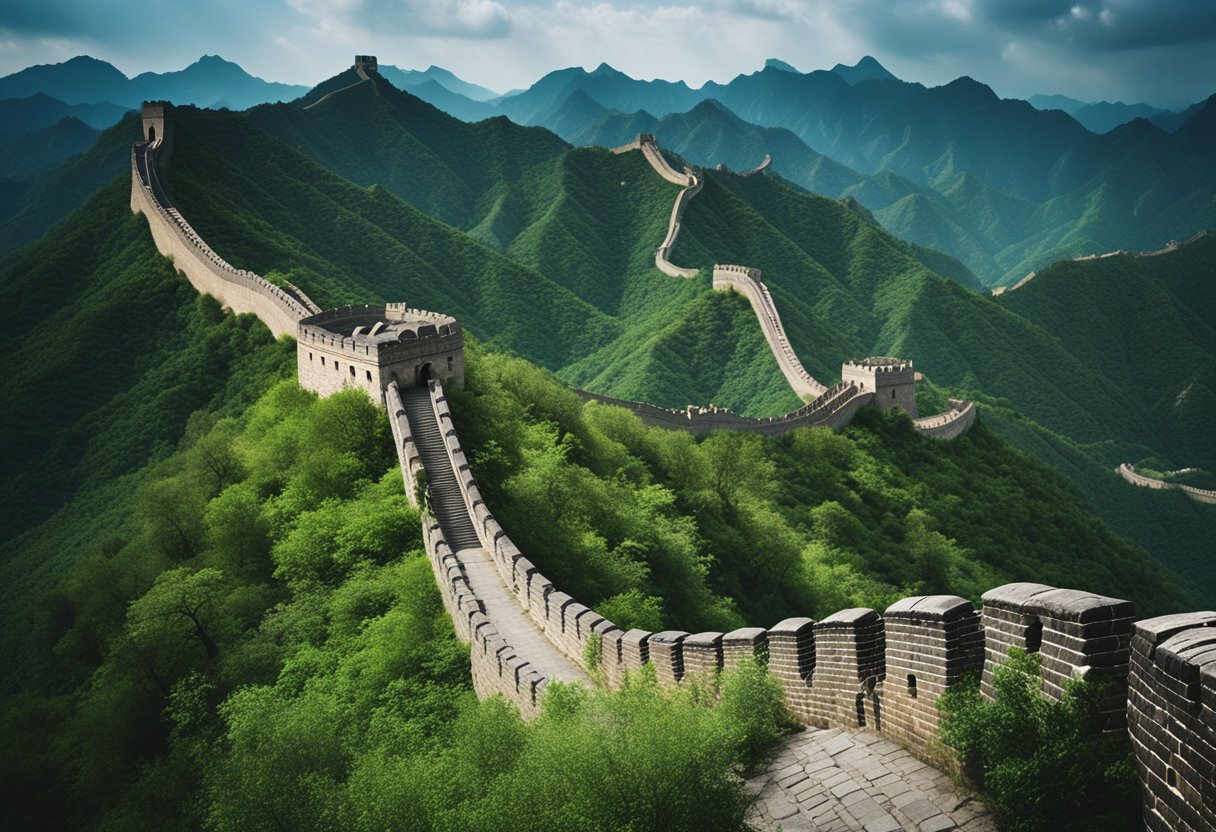
In this section, we examine the ecological dynamics around the Great Wall and how climate patterns influence this monumental structure and its surroundings.
Ecological Concerns
The fortification has stood for centuries against the elements, but it now faces ecological challenges. Erosion, a result of wind and rain, threatens this ancient marvel. Interestingly, biocrusts have formed a protective layer over parts of the wall, warding off erosion. Biocrusts are crucial for the ecological balance, as they help in stabilising soils and thereby protecting ancient structures against natural forces.
Climate Influence
Fluctuating climate patterns have a notable impact on the Great Wall, from the mountains it spans to the diverse environment it traverses. Seasonal wind patterns and temperature variations influence the wildlife habitats surrounding the wall, and studying these patterns helps us understand and potentially mitigate negative impacts. A deeper understanding of these environmental interactions enriches our approach to preservation efforts.
Myths and Misconceptions
Exploring various legends and lore about the Great Wall of China, we find that many are steeped in misconception and popular myth. Our investigation aims to clarify these points.
Debunking Popular Myths
One of the most pervasive myths about the Great Wall is its visibility from space. Contrary to popular belief, astronauts have confirmed that the Great Wall is not visible from space with the naked eye under normal conditions. This myth may have been perpetuated by an overestimation of the Wall’s size and the sheer difficulty of spotting it among vast landscapes from such a distance.
Legends have also given rise to the notion of the Great Wall being a single, unbroken structure. In reality, the Wall is a series of fortifications made of various materials, including earth, brick, and wood, built over successive Chinese dynasties.
Misconceptions in Media
Media representations often amplify the Great Wall’s mystique by embracing exaggerated claims and dramatising its history. Films and documentaries sometimes suggest that the Wall was more effective at keeping out invaders than it actually was. The truth is that, while imposing, the Great Wall did not always prevent invasions, and many enemies managed to breach it at various points in history.
Additionally, portrayals in media can sometimes sacrifice historical accuracy for the sake of storytelling, leading to further misconceptions about the Great Wall’s purpose and effectiveness.
By confronting these myths and misconceptions, we can illuminate the Great Wall’s true magnificence beyond the legend and folklore.
Frequently Asked Questions
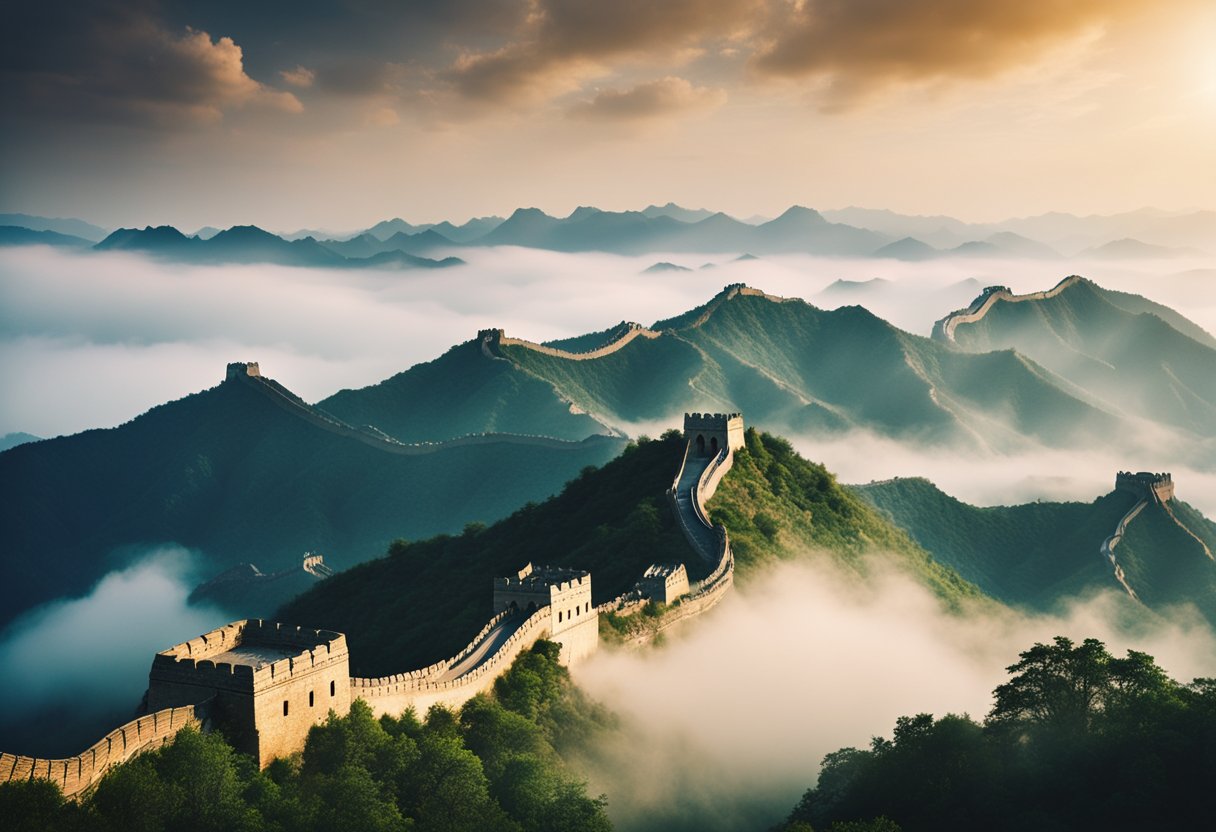
In addressing the intrigues surrounding the Great Wall of China, our exploration uncovers some truths behind the ancient myths and reveals its undeniable stature in the world’s cultural heritage.
Why was the Great Wall constructed?
The Great Wall was erected primarily to defend against invasions and raids by nomadic groups and military incursions. Over millennia, its construction evolved to serve as both a physical barricade and a symbol of the Imperial dynasties’ strength and resolve.
Which dynasties contributed to the construction of the Great Wall?
Several dynasties played pivotal roles in the construction of the Great Wall. The Qin, Han, and Ming dynasties are among the most notable contributors, each reinforcing and extending the Wall to safeguard their realms.
How extensive is the Great Wall, and what are its dimensions?
The full extent of the Great Wall spans over 5,500 miles, and its architectural expanse stretches across diverse terrains from east to west of China. Although its dimensions vary, the Ming dynasty’s construction boasts substantial height and width throughout its length.
What are the mythological stories associated with the Great Wall of China?
Legends have woven themselves into the fabric of the Great Wall’s history. One such tale is about Meng Jiangnu, who wept over the Wall upon learning of her husband’s death during its construction, leading a section to collapse from the force of her sorrow.
In what ways is the Great Wall considered to symbolise cultural heritage?
The Great Wall transcends its original military purpose, symbolising the architectural ingenuity and enduring spirit of Chinese civilisation. It embodies centuries of cultural exchange and adaptation, reflecting the myriad dynasties that shaped its contours.
Could you elaborate on the Great Wall’s reputation as a vast graveyard?
While it is not a graveyard in the literal sense, the Great Wall is thought to contain the remains of the workers who perished during its arduous construction. It’s an enduring testament to the immense human effort and sacrifice that the Wall represents.



